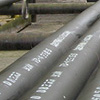

Hunan Standard Steel as a member of Husteel Industry Group, is a professional manufacturer of mild steel pipes and pipe fittings, which has a complete system of production... More
Factory GroupEasy to Crack Situation for Stainless Steel Pipe
Date:2016-11-25
Views:2384
At room temperature, deformation-induced martensite was produced in both tensile, bending and rolling conditions, and the content of stainless steel increased with the increase of cold working deformation. A lot of experiments show that the deformed layers, deformed twins and strain-induced martensite appear in different degree during the deformation process of the seamless tube, and dislocation plugged and dislocated cellular structure are formed near the grain boundary and annealing twin.
These deformed microstructures contribute to work hardening. Seamless solution for the main purpose is to eliminate the material to reduce stress and hardness, improve the formability of stainless steel seamless pipe. The hardness after treatment is too high that the softening effect is poor, the residual stress is not fully released, because the residual stress caused by lattice distortion will also change the hardness value. It is due to the presence of residual stress, resulting in stainless steel tube flaring easy to stress concentration where the cracks, thus affecting the flaring performance. As the grain boundaries and grain boundaries on both sides of the grain orientation difference, increasing the resistance of dislocation slip in the crystal, so the main role of grain boundary is to impede dislocation movement. The finer the grains, the more the grain boundaries, the greater the resistance to dislocation slip, the higher the yield strength of the steel, the formation of grain boundary strengthening, resulting in work hardening; so the smaller the grain in the flaring The more prone to work hardening.
These deformed microstructures contribute to work hardening. Seamless solution for the main purpose is to eliminate the material to reduce stress and hardness, improve the formability of stainless steel seamless pipe. The hardness after treatment is too high that the softening effect is poor, the residual stress is not fully released, because the residual stress caused by lattice distortion will also change the hardness value. It is due to the presence of residual stress, resulting in stainless steel tube flaring easy to stress concentration where the cracks, thus affecting the flaring performance. As the grain boundaries and grain boundaries on both sides of the grain orientation difference, increasing the resistance of dislocation slip in the crystal, so the main role of grain boundary is to impede dislocation movement. The finer the grains, the more the grain boundaries, the greater the resistance to dislocation slip, the higher the yield strength of the steel, the formation of grain boundary strengthening, resulting in work hardening; so the smaller the grain in the flaring The more prone to work hardening.





















